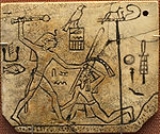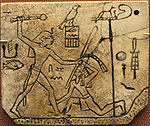
Hieroglyphics: The Writings of Ancient Egypt
Encyclopedia
The Egyptian hieroglyphics
text Hieroglyphics: The Writings of Ancient Egypt is one of the modern primer
s on the Egyptian language
hieroglyphs, from the late 20th to early 21st century. The text is authored by Maria Carmela Betrò, c. 1995, (English 1996).
The standard version of analytic Egyptian hieroglyphs is based upon the 26 categories of the Gardiner's Sign List
, (about 700 signs). That categorization is still the basic standard. The approach in Hieroglyphics: The Writings of Ancient Egypt is to use some of the Gardiner sign categories, to focus on specific major-use signs. The end of a thematic chapter then has synoptic
write-ups for additional lesser used signs, or a sign from another category that is 'related'.
Betrò's book has the following standard categories, as chapters:
As can be seen the 26 categories of Gardiner's Sign List
has been reduced to 7. There is no specific category for the Unclassified signs, Signs from Demotic
, or the problematic signs.
With the older styles and outlines of hieroglyphs being redone and rethought by modern Egytologists, new approaches to books on the Egyptian language
and the hieroglyphs have been tried.
 The Origins section contains photos of the Libyan Palette
The Origins section contains photos of the Libyan Palette
, sides A, B; also the Narmer Palette
, sides A, B, and the "Four Dogs Palette" at the Louvre. The Min Palette
is also referenced in the text pages, as well as items specific to the cosmetic palette
s of Ancient Egypt
. It also explains the Old Kingdom
label (Ancient Egypt), (for Pharaoh Den
), with some of the oldest used hieroglyph sign examples, and also discusses the signs upon pottery
.
The English text is 251 pages, and contains a short word glossary for 29 entries, a one page bibliography, and a five page index.
The Gardiner sign list covers five pages, with the 650+ signs, with hieroglyph topic pages in the red color for the glyph and a page number-adjacent, as a location key.
Egyptian hieroglyphs
Egyptian hieroglyphs were a formal writing system used by the ancient Egyptians that combined logographic and alphabetic elements. Egyptians used cursive hieroglyphs for religious literature on papyrus and wood...
text Hieroglyphics: The Writings of Ancient Egypt is one of the modern primer
Primer (textbook)
A primer is a first textbook for teaching of reading, such as an alphabet book or basal reader. The word also is used more broadly to refer to any book that presents the most basic elements of a subject....
s on the Egyptian language
Egyptian language
Egyptian is the oldest known indigenous language of Egypt and a branch of the Afroasiatic language family. Written records of the Egyptian language have been dated from about 3400 BC, making it one of the oldest recorded languages known. Egyptian was spoken until the late 17th century AD in the...
hieroglyphs, from the late 20th to early 21st century. The text is authored by Maria Carmela Betrò, c. 1995, (English 1996).
The standard version of analytic Egyptian hieroglyphs is based upon the 26 categories of the Gardiner's Sign List
Gardiner's Sign List
Gardiner's Sign List is a list of common Egyptian hieroglyphs compiled by Sir Alan Gardiner. It is considered a standard reference in the study of Ancient Egyptian hieroglyphs....
, (about 700 signs). That categorization is still the basic standard. The approach in Hieroglyphics: The Writings of Ancient Egypt is to use some of the Gardiner sign categories, to focus on specific major-use signs. The end of a thematic chapter then has synoptic
Synopsis
A synopsis is a brief summary of the major points of a written work, either as prose or as a table; an abridgment or condensation of a work.-See also:*Synopsys, an electronic design automation company based in Mountain View, California...
write-ups for additional lesser used signs, or a sign from another category that is 'related'.
Betrò's book has the following standard categories, as chapters:
- Mankind
- Gods
- Animals
- Trees and Plants
- Sky, Earth, Water
- The House
- The City, Palace, and Temples
- Arts and Trades
As can be seen the 26 categories of Gardiner's Sign List
Gardiner's Sign List
Gardiner's Sign List is a list of common Egyptian hieroglyphs compiled by Sir Alan Gardiner. It is considered a standard reference in the study of Ancient Egyptian hieroglyphs....
has been reduced to 7. There is no specific category for the Unclassified signs, Signs from Demotic
Demotic (Egyptian)
Demotic refers to either the ancient Egyptian script derived from northern forms of hieratic used in the Delta, or the stage of the Egyptian language following Late Egyptian and preceding Coptic. The term was first used by the Greek historian Herodotus to distinguish it from hieratic and...
, or the problematic signs.
With the older styles and outlines of hieroglyphs being redone and rethought by modern Egytologists, new approaches to books on the Egyptian language
Egyptian language
Egyptian is the oldest known indigenous language of Egypt and a branch of the Afroasiatic language family. Written records of the Egyptian language have been dated from about 3400 BC, making it one of the oldest recorded languages known. Egyptian was spoken until the late 17th century AD in the...
and the hieroglyphs have been tried.
Text specifics
The text starts with a history, and The Origins; also The Gardiner List, Chronological Table, and the The Principles of Hieroglyphic Writing.
Libyan Palette
The Libyan Palette is the surviving lower portion of a stone cosmetic palette bearing carved decoration and writing. It dates from the Naqada III or Protodynastic Period of Egypt...
, sides A, B; also the Narmer Palette
Narmer Palette
The Narmer Palette, also known as the Great ierakonpolis Palette or the Palette of Narmer, is a significant Egyptian archeological find, dating from about the 31st century BC, containing some of the earliest hieroglyphic inscriptions ever found. It is thought by some to depict the unification of...
, sides A, B, and the "Four Dogs Palette" at the Louvre. The Min Palette
Min Palette
The Min Palette, or El Amrah Palette is an ancient Egyptian cosmetic palette from El Amrah , found in Naqada, tomb B62. It is held in the British Museum, no. 35501.-Description:...
is also referenced in the text pages, as well as items specific to the cosmetic palette
Cosmetic palette
The cosmetic palettes of middle to late predynastic Egypt are archaeological artifacts, originally used to grind and apply ingredients for facial or body cosmetics. The decorative palettes of the late 4th millennium BCE appear to have lost this function and became commemorative, ornamental, and...
s of Ancient Egypt
Ancient Egypt
Ancient Egypt was an ancient civilization of Northeastern Africa, concentrated along the lower reaches of the Nile River in what is now the modern country of Egypt. Egyptian civilization coalesced around 3150 BC with the political unification of Upper and Lower Egypt under the first pharaoh...
. It also explains the Old Kingdom
Old Kingdom
Old Kingdom is the name given to the period in the 3rd millennium BC when Egypt attained its first continuous peak of civilization in complexity and achievement – the first of three so-called "Kingdom" periods, which mark the high points of civilization in the lower Nile Valley .The term itself was...
label (Ancient Egypt), (for Pharaoh Den
Den (Pharaoh)
Den, also known as Hor-Den, Dewen and Udimu, is the Horus name of an early Egyptian king who ruled during the 1st dynasty. He is the best archaeologically attested ruler of this period. Den is said to have brought prosperity to his realm and numerous innovations are attributed to his reign...
), with some of the oldest used hieroglyph sign examples, and also discusses the signs upon pottery
Pottery
Pottery is the material from which the potteryware is made, of which major types include earthenware, stoneware and porcelain. The place where such wares are made is also called a pottery . Pottery also refers to the art or craft of the potter or the manufacture of pottery...
.
The English text is 251 pages, and contains a short word glossary for 29 entries, a one page bibliography, and a five page index.
The Gardiner sign list covers five pages, with the 650+ signs, with hieroglyph topic pages in the red color for the glyph and a page number-adjacent, as a location key.

